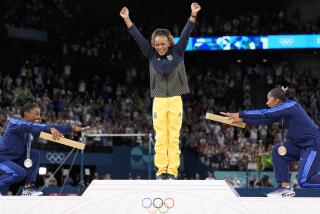Seles Reminds Hingis of Past
- Share via
PARIS — No wonder Martina Hingis looked adrift and amiss Thursday in the second set of her semifinal match against Monica Seles at the French Open.
It was as though she had found a stranger in her house. Clearly, this was not the Monica Seles she thought she knew.
An interloper strolled onto the court at Roland Garros and turned Hingis’ neat little 17-year-old world upside down. Seles and her thunderous ground strokes shook Hingis and the tennis world with startling results. The sixth-seeded Seles defeated the top-seeded Hingis, 6-3, 6-2, in 69 minutes, finishing it with a backhand passing shot.
Hingis’ hopes for a Grand Slam are over, and Saturday, Seles will play for her fourth French Open title, facing fourth-seeded Arantxa Sanchez Vicario of Spain. Sanchez Vicario, surviving a few nervous moments, defeated second-seeded Lindsay Davenport of Newport Beach, 6-3, 7-6 (7-5), in an earlier semifinal.
“It’s nice to see some sunshine after so many clouds,” Seles said.
Here, Seles, 24, has gone beyond being a sentimental favorite. Her father and coach, Karolj, died May 14 after a lengthy battle with stomach cancer, and Seles almost did not enter the French Open, doing some soul-searching with her mother, Esther, and new coach, Gavin Hopper.
When Seles appeared in Paris--wearing her father’s wedding ring on her necklace--her mind-set was day to day. But she has such skill that minimal preparation was enough to get her into the second week.
“Yesterday’s practice was 100% perfect,” Hopper said. “She hit the ball so well. I thought, ‘This will be interesting now.’ I thought she had a real chance at that point. It’s easy to say that now. It sort of gave me a little tingle.”
Hingis appeared totally caught off guard. In five previous matches, she had never lost to Seles, including a three-set semifinal meeting here in 1997. Last year, Hingis was so dominant, she did not lose her second match until August, to Davenport at Manhattan Beach.
In 1998, she has lost five times, twice to Venus Williams and once each to Anna Kournikova, Davenport, and now Seles. But the other losses were not quite this one-sided.
“I guess she surprised everybody,” Hingis said. “She’s been around for quite a while and then she was gone for almost four years. And here she is back, in better shape, probably better than ever.”
Hingis struggled with her forehand as well as her serve. She was broken five times and committed 31 unforced errors, 20 in the second set.
The most visible example of her struggles came in the final game of the first set, trailing, 3-5. Hingis double-faulted twice, and lost it at 15.
“She [Hingis] got a little bit frustrated that Monica was taking control of the points so quickly,” Hopper said. “They all know what Monica can do, but they’ve never actually played her at her best. Every second serve you give her, she’s going to be putting it down your throat. That’s pretty tough stuff. Hingis probably hasn’t come up against her in that sort of situation.”
Said Hingis: “She’s just a level better than the other ones I’ve played. . . . There are players like Monica, like Mary Pierce, also Venus, [who] have power like that. But not from every corner of the court like Monica.”
Hingis has been the top player in the world for more than a year, winning four of the last five Grand Slam events. Some have suggested, including television commentator John McEnroe, that her success has come in something of a vacuum, not having to face the best of Seles and Steffi Graf.
After Seles was stabbed in the back by a crazed fan of Graf’s in 1993, she has never been quite the same. Before the stabbing, she had won eight Grand Slam titles (including three French Opens), and she won one more afterward, the 1996 Australian Open.
“I don’t think the real Monica has ever left. . . . [But] it’s not the same as it was before the stabbing,” she said. “It never will be, and I don’t want it to be.”
Seles was off the tour more than two years after the stabbing. Just as she was finding herself on the court again, her father’s cancer returned. She played a limited schedule, skipping the Australian Open to be with him.
“In a weird way, I have a peace of mind,” Seles said. “In Rome [at the Italian Open], I felt I played a lot better tennis, but my mind just wasn’t on the court.”
Seles has not turned the tournament into a tribute to her father. She has worn a black outfit in all but one of her matches, but said it might be one of those subconscious things.
“I miss him tremendously,” she said. “But win or lose, it doesn’t make a difference in me thinking about my dad or not thinking about him.”
The final will be a rematch of 1991, in which Seles easily defeated Sanchez Vicario. Sanchez Vicario’s semifinal against Davenport was of subpar quality--Davenport did not hold serve in the first set and held only twice in the second.
Davenport, in her third Grand Slam semifinal, had 56 unforced errors and had problems with her overhead, including one she missed on match point.
“Next time, I’m just not going to play this bad. That’s what I tell myself,” said Davenport, who lost the final four points of the tiebreaker.
“My backhand was just bad today. I think I lost confidence when I got close. She was getting really tight. In turn, I think that made me get a little bit tight.’
More to Read
Go beyond the scoreboard
Get the latest on L.A.'s teams in the daily Sports Report newsletter.
You may occasionally receive promotional content from the Los Angeles Times.











